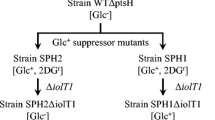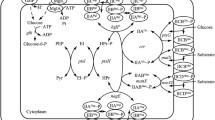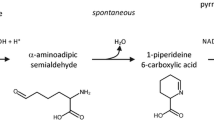Abstract
Corynebacterium glutamicum uses the phosphoenolpyruvate-dependent sugar phosphotransferase system (PTS) to uptake and phosphorylate glucose; no other route has yet been identified. Disruption of the ptsH gene in wild-type C. glutamicum resulted, as expected, in a phenotype exhibiting little growth on any of the PTS sugars: glucose, fructose, and sucrose. However, a suppressor mutant that grew on glucose but not on the other two sugars was spontaneously isolated from the PTS-negative strain WTΔptsH. The suppressor strain SPH2, unlike the wild-type strain, exhibited a phenotype of resistance to 2-deoxyglucose which is known to be a toxic substrate for the glucose-PTS of this microbe, suggesting that strain SPH2 utilizes glucose via a different system involving a permease and native glucokinases. Analysis of the C. glutamicum genome sequence using Escherichia coli galactose permease, which can transport glucose, led to the identification of two candidate genes, iolT1 and iolT2, both of which have been reported as myo-inositol transporters. When cultured on glucose medium supplemented with myo-inositol, strain WTΔptsH was able to consume glucose, suggesting that glucose uptake was mediated by one or more myo-inositol-induced transporters. Overexpression of iolT1 alone and that of iolT2 alone under the gapA promoter in strain WTΔptsH rendered the strain capable of growing on glucose, proving that each transporter played a role in glucose uptake. Disruption of iolT1 in strain SPH2 abolished growth on glucose, whereas disruption of iolT2 did not, revealing that iolT1 was responsible for glucose uptake in strain SPH2. Sequence analysis of the iol gene cluster and its surrounding region identified a single-base deletion in the putative transcriptional regulator gene Cgl0157 of strain SPH2. Introduction of the frameshift mutation allowed strain WTΔptsH to grow on glucose, and further deletion of iolT1 abolished the growth again, indicating that inactivation of Cgl0157 under a PTS-negative background can be a means by which to express the iolT1-specified glucose uptake bypass instead of the native PTS. When this strategy was applied to a defined lysine producer, the engineered strain displayed increased lysine production from glucose.







Similar content being viewed by others
References
Arndt A, Eikmanns BJ (2008) Regulation of carbon metabolism in Corynebacterium glutamicum. In: Burkovski A (ed) Corynebacteria: genomics and molecular biology. Caister Academic Press, Norwich, pp 1–6
Blombach B, Seibold GM (2010) Carbohydrate metabolism in Corynebacterium glutamicum and applications for the metabolic engineering of l-lysine production strains. Appl Microbiol Biotechnol 87:703–713
Chen R, Yap WM, Postma PW, Bailey JE (1997) Comparative studies of Escherichia coli strains using different glucose uptake systems: metabolism and energetics. Biotechnol Bioeng 56:583–590
Cocaign-Bousquet M, Guyonvarch A, Lindley ND (1996) Growth rate-dependent modulation of carbon flux through central metabolism and the kinetic consequences for glucose-limited chemostat cultures of Corynebacterium glutamicum. Appl Environ Microbiol 62:429–436
Curtis SJ, Epstein W (1975) Phosphorylation of d-glucose in Escherichia coli mutants defective in glucosephosphotransferase, mannosephosphotransferase, and glucokinase. J Bacteriol 122:1189–1199
Flores N, Xiao J, BerryA BF, Valle F (1996) Pathway engineering for the production of aromatic compounds in Escherichia coli. Nat Biotechnol 14:620–623
Gourdon P, Raherimandimby M, Dominguez H, Cocaign-Bousquet M, Lindley ND (2003) Osmotic stress, glucose transport capacity and consequences for glutamate overproduction in Corynebacterium glutamicum. J Biotechnol 104:77–85
Ikeda M (2003) Amino acid production processes. In: Faurie R, Thommel J (eds) Adv Biochem Eng Biotechnol vol 79, microbial production of L-amino acids. Springer, Berlin, pp 1–35
Ikeda M, Takeno S, Mizuno Y, Mitsuhashi S (2010) Process for producing useful substance. WO 2010/024267 A1
Kinoshita S, Nakayama K (1978) Amino acids. In: Rose AH (ed) Primary products of metabolism. Academic, London, pp 209–261
Kotrba P, Inui M, Yukawa H (2001) The ptsI gene encoding enzyme I of the phosphotransferase system of Corynebacterium glutamicum. Biochem Biophys Res Commun 289:1307–1313
Krings E, Krumbach K, Bathe B, Kelle R, Wendisch VF, Sahm H, Eggeling L (2006) Characterization of myo-inositol utilization by Corynebacterium glutamicum: the stimulon, identification of transporters, and influence on l-lysine formation. J Bacteriol 188:8054–8061
Lindner SN, Knebel S, Pallerla SR, Schoberth SM, Wendisch VF (2010) Cg2091 encodes a polyphosphate/ATP-dependent glucokinase of Corynebacterium glutamicum. Appl Microbiol Biotechnol 87:703–713
Mitsuhashi S, Ohnishi J, Hayashi M, Ikeda M (2004) A gene homologous to β-type carbonic anhydrase is essential for the growth of Corynebacterium glutamicum under atmospheric conditions. Appl Microbiol Biotechnol 63:592–601
Moon MW, Park SY, Choi SK, Lee JK (2007) The phosphotransferase system of Corynebacterium glutamicum: features of sugar transport and carbon regulation. J Mol Microbiol Biotechnol 12:43–50
Mori M, Shiio I (1987) Phosphoenolpyruvate: sugar phosphotransferase systems and sugar metabolism in Brevibacterium flavum. Agric Biol Chem 51:2671–2678
Ohnishi J, Mitsuhashi S, Hayashi M, Ando S, Yokoi H, Ochiai K, Ikeda M (2002) A novel methodology employing Corynebacterium glutamicum genome information to generate a new l-lysine-producing mutant. Appl Microbiol Biotechnol 58:217–223
Parche S, Burkovski A, Sprenger GA, Weil B, Krämer R, Titgemeyer F (2001) Corynebacterium glutamicum: a dissection of the PTS. J Mol Microbiol Biotechnol 3:423–428
Park SY, Kim HK, Yoo SK, Oh TK, Lee JK (2000) Characterization of glk, a gene coding for glucose kinase of Corynebacterium glutamicum. FEMS Microbiol Lett 188:209–215
Peters-Wendisch PG, Schiel B, Wendisch VF, Katsoulidis E, Möckel B, Sahm H, Eikmanns BJ (2001) Pyruvate carboxylase is a major bottleneck for glutamate and lysine production by Corynebacterium glutamicum. J Mol Microbiol Biotechnol 3:295–300
Sambrook J, Russell DW (2001) Molecular cloning: a laboratory manual, 3rd edn. Cold Spring Harbor Laboratory Press, Cold Spring Harbor
Takeno S, Ohnishi J, Komatsu T, Masaki T, Sen K, Ikeda M (2007) Anaerobic growth and potential for amino acid production by nitrate respiration in Corynebacterium glutamicum. Appl Microbiol Biotechnol 75:1173–1182
Yokota A, Lindley ND (2005) Central metabolism: sugar uptake and conversion. In: Eggeling E, Bott M (eds) Handbook of Corynebacterium glutamicum. CRC, Boca Raton, pp 215–240
Acknowledgements
We thank Dr. Ozaki for encouraging support of our work, and also Drs. S. Hashimoto, S. Koizumi, and Y. Yonetani for their useful discussions.
Author information
Authors and Affiliations
Corresponding author
Rights and permissions
About this article
Cite this article
Ikeda, M., Mizuno, Y., Awane, Si. et al. Identification and application of a different glucose uptake system that functions as an alternative to the phosphotransferase system in Corynebacterium glutamicum . Appl Microbiol Biotechnol 90, 1443–1451 (2011). https://doi.org/10.1007/s00253-011-3210-x
Received:
Revised:
Accepted:
Published:
Issue Date:
DOI: https://doi.org/10.1007/s00253-011-3210-x




